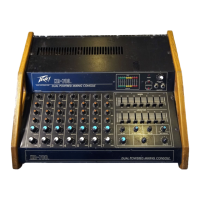
Do you have a question about the Peavey XR-700 and is the answer not in the manual?
| Type | Powered Mixer |
|---|---|
| Channels | 7 |
| Equalization | 3-Band EQ per channel |
| Power Output | 700W |
| Effects | Digital Reverb, Delay, Chorus |
| EQ | 3-band EQ per channel |
| Frequency Response | 20Hz - 20kHz |
Overview of the XR-700 dual powered mixer, highlighting its monitor function focus and versatile features.
Adjusts input preamp gain for optimal signal-to-noise ratio and headroom for channel and master levels.
Sets monitor mix levels using independent 'pre' monitor sends before channel EQ and level controls.
Features three-band active EQ with shelving low/high and peak/notch mid filters for precise tone shaping.
Provides 15 dB boost/cut at 60 Hz with a sloping characteristic for low-end shaping.
Offers 15 dB boost/cut at 600 Hz with a peak/notch filter for midrange control.
Features 15 dB boost/cut at 8 KHz with a shelving characteristic for high-end shaping.
Adjusts signal level to the effects mix buss for internal reverb or external effects units.
Sets the overall gain for the main mixing buss and output to the main line out.
Adjusts the gain of the monitor mixing buss and output to the monitor line out.
Controls signal level sent to the internal reverberation system and effects output.
Determines the amount of delayed signal (reverberation) mixed back into the main mix buss.
Varies the 'timbre' of the reverb drive circuitry for precise matching to program material.
Blends internal reverb and effects signals into the monitor mixing buss for enhanced monitoring.
Controls gain of the effects return preamp, feeding the main and monitor mixing busses.
Describes graphic equalizer connection through input switching jacks to main outputs under normal use.
Explains using graphic equalizers and power amps for external systems via patching.
Details using master graphic equalizers for room equalization, feedback control, and system balance.
Provides guidance on using graphic equalizers for effective feedback suppression.
Utilizes 'Distortion Detection Technique' to maximize amp performance and prevent clipping.
LEDs indicate when DDT compression is active, showing gain reduction during operation.
Indicates when the electrical supply is switched on and power is being delivered.
Dual ten-segment LED displays provide instantaneous output signal level indication.
Controls headphone output level for both main and monitor jacks, acting as a sublevel.
Provides headphone signal from the monitor amplifier, controlled by the headphone level control.
Provides headphone signal from the main amplifier, controlled by the headphone level control.
Features balanced (low Z) and unbalanced (high Z) inputs for microphones and program sources.
Allows in-line patching of auxiliary effects or equalizers via stereo send/receive jacks.
Line level access points to mixing busses for paralleling mixers or direct signal injection.
Jack for remote control of the reverberation function using a standard footswitch.
Input for effects return preamp, handling various signal levels and connecting to the main mix.
Outputs for matching to professional line or instrument level effects devices.
Provides a mix of main and monitor systems for external devices or tape recording.
Input jacks to facilitate patching signals directly to the internal power amplifiers.
Patching jacks for graphics, allowing external patching or disconnection from mixer.
Primary signal outputs from main and monitor mixing amplifiers for patching to other systems.
Connects speaker systems to the two internal 100 watt power amplifiers.
Protective fuse for the unit, requiring replacement with the proper type and value if it fails.
Three-position switch for power control, including an 'off' position and optimized 'on' positions.
Three-wire line cord with grounding for safety, advising against removing the ground pin.
